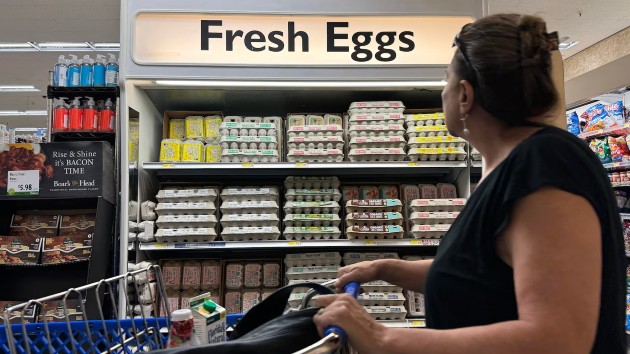
(WASHINGTON, D.C.) -- Inflation has fallen over the final months of the presidential campaign, carrying potential implications for a tight race between former President Donald Trump and Vice President Kamala Harris.
More than half of adults list inflation as a top issue for the country, making it the highest-ranking concern by a wide margin over issues like immigration, crime and abortion, according to an Ipsos poll conducted late last month.
Price increases nationwide have largely returned to normal. However, the presidential race is widely expected to hinge on the results in seven closely contested battleground states, placing importance on where inflation stands in those key locations.
An analysis by ABC News found that inflation rates vary significantly across four major cities situated in battleground states: Detroit, Michigan; Phoenix, Arizona; Atlanta, Georgia; and Philadelphia, Pennsylvania.
In each of those states, the average polling margin between the two candidates is no more than two percentage points, according to FiveThirtyEight.
Here's what to know about what inflation looks like in swing-state cities and what that means for the election:
Detroit, Michigan
Consumer prices rose 3.5% in Detroit over the year ending in August, according to data from the U.S. Bureau of Labor Statistics (BLS). That figure stands a percentage point above the national average and marks the highest inflation rate of the four cities examined by ABC News.
The surge in prices has stemmed in large part from rapidly rising housing costs, Gabriel Ehrlich, an economist at the University of Michigan, told ABC News. The trend marks a recent turnabout from sluggish housing prices that had taken hold in the city in the aftermath of the 2008 Great Recession.
Back then, a crisis in the auto industry caused rising unemployment, an exodus from Detroit and diminishing demand for homes. As Detroit has since improved its economic performance, however, the population has begun to grow and housing prices have started to soar. Housing costs climbed 6.2% in Detroit over the year ending in August, which stands more than a percentage point higher than the national average.
Even if the improved economic performance has contributed to the rise in housing prices, that silver lining offers little solace for city residents paying high costs, Ehrlich said.
"That's a hard sell," he added.
Phoenix, Arizona
In Phoenix, the inflation rate clocks in at 2.3%, according to BLS data for August, the most recent month on record. That pace of price increases is slightly lower than the national average.
Like Detroit, housing prices play a significant role in the dynamic behind costs in Phoenix – but it's for the opposite reason. Housing prices there are rising at a pace of 3.5%, well below the national average of more than 6%.
The moderate pace of current housing price increases in Phoenix marks welcome relief after a bruising stretch of skyrocketing costs, Lee McPheters, director of the JPMorgan Chase Economic Outlook Center at Arizona State University, told ABC News. Since 2017, housing prices in the Phoenix area have doubled, he added.
The price increases have slowed, however, as Phoenix has made a concerted effort to ramp up home construction and address its dearth of supply.
Phoenix is expected to build roughly 20,000 apartments in 2024, granting it the fourth-highest apartment construction rate of any U.S. city, a RentCafe study in August found. That total would amount to a 88% increase from the apartment construction rate achieved two years prior, according to the Maricopa Association of Governments.
"There's of course been the same housing shortage issues in Phoenix that you see across the country," McPheters said. "The difference here is that Arizona responded."
Atlanta, Georgia
As of August, the inflation rate in Atlanta stands at 1.7%, which clocks in nearly a percentage point lower than the national average and is the lowest pace for any of the swing-state cities examined by ABC News.
Prices in Atlanta have risen at a slower pace than the national average for a range of essential products, including housing, meat, poultry, fish and eggs.
Gasoline prices have dropped nationwide over the past year but they've fallen even more in Atlanta. The same trend applies to the price of new and used cars, the latter of which has fallen a staggering 11% over the past year.
Philadelphia, Pennsylvania
Consumer prices in the Philadelphia area climbed 3.4% over the year ending in August, BLS data showed. The city's inflation rate registers nearly a percentage point higher than the national average.
In Philadelphia, prices for many food and beverage products are rising faster than the national average. Over the past year, prices for meat, poultry, fish and eggs have climbed at more than twice the national average pace. Cereal and bakery products have surged 2.5% over the past year in Philadelphia, even though prices for such goods have fallen by 1% nationwide.
The prices for nonalcoholic beverages in Philadelphia have climbed more than six times faster than the national average over the past year.
Erasmus Kersting, a professor of economics at Villanova University, said the sharp increase in prices for some food items may owed to a lack of competition among grocery stores in Philadelphia. In the absence of fierce competition, grocery stores retain the latitude to raise prices without fear of a rival offering a better deal on comparable products, Kersting explained.
Two supermarket chains, Giant and ShopRite, accounted for 56% of the local grocery market in 2022, according to the Philadelphia Business Journal.
"Grocery store prices have gone up a lot," Kersting told ABC News. "Some of this has to do with market structure. How many competitors do grocery stores have?"
Copyright © 2024, ABC Audio. All rights reserved.

